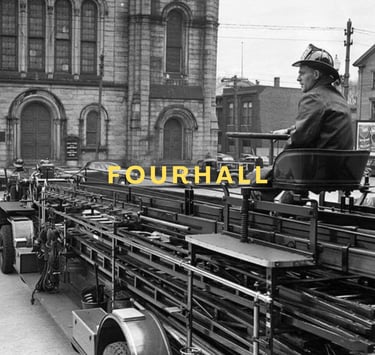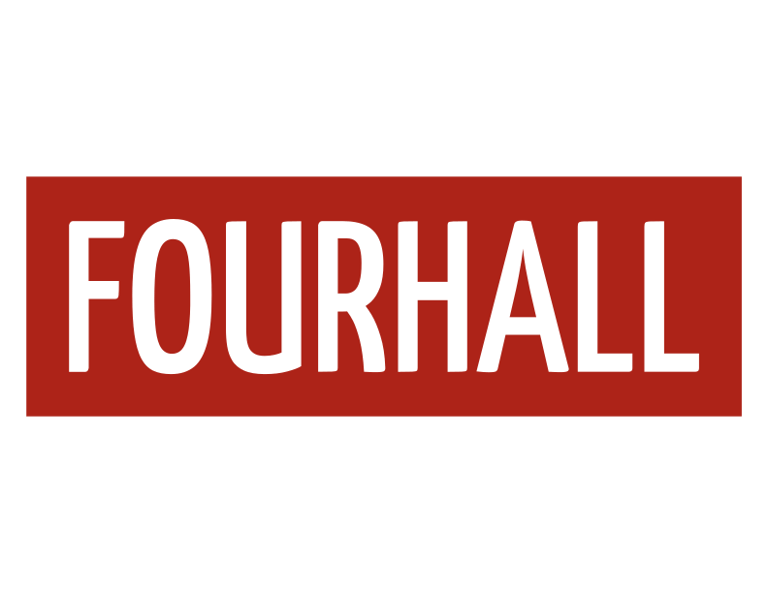EP3: Then and Now - Transcript


This episode traces the fire service from its early bucket brigades to today’s EMS-driven work, showing how tradition and hard-earned lessons built a culture rooted in readiness and trust.
[SHOW OPENS]
Cory Ashworth 00:00 - 00:47
Welcome to Fourhall. My name is Cory Ashworth. This is episode 3, Then and Now. To understand the fire service today, you have to understand how it was built. Firefighting is one of the few professions where ritual and readiness are inseparable. Long before formal training programs or NFPA standards, preparation and routine were what held departments together. More than a century ago, readiness was physical. The horses hitched and the steam pumps ready to go. Today it means knowing your equipment, your crew, and staying ready long before the call comes in. Aaron Fields puts it simply:
Aaron Fields 00:48 - 01:04
For me what I realized early on was that my work ethic was the only thing I really had control over. And I don't like to lose and I know that people that are prepared are more successful.
Cory Ashworth 01:04 - 02:13
Right there? That's the legacy we inherit. A culture where readiness isn't luck. It's built through repetition, structure, and trust. So in this episode, we'll look at how departments are organized, why medical calls became central to the job, and how those systems evolved into what we practice today. We're tracing a line from then to now. The history of the fire service. The culture, the structure, the gear, it didn't just appear overnight. It was built slowly, out of necessity and often disaster. And for most firefighters, a story, a moment that pulled them in. Long before pagers and radios, the call to action was a sound that could shake the night, an air raid siren echoing across town. For Chief Drakeley, at six years old, that sound was everything.
Chief Martin Drakeley 02:15 - 03:23
So my old man had been a firefighter for, I don't know, 11 years. And you could listen to that go and when it went, obviously everybody took off from home and went to respond to the call. So I could remember hearing that like two o'clock in the morning and I would make a point of racing my dad to the back door to see if I could actually make it to a call. And I did that ever since I was a young kid. So it was definitely my dad's influence. I can remember a specific call where sirens went off. I raced them to the back door. And then I waited outside to see which way the engines would go. So from the siren, if they were going away, obviously it was quieter. They were going the other way. But it started to get louder. And I could hear the truck siren coming. Back then, they were riding the tailboard. So you could see guys coming. There's two guys in the cab, a two-man cab, and then four guys on the back. and I could see my dad on the back riding the tailboard, going to a call and that was pretty much the time where it solidified it for me that that's what I was gonna do.
Cory Ashworth 03:31 - 06:57
In both Canada and the United States, the story of the fire service starts early, back in colonial times. Boston passed its first fire regulations in 1630, almost 400 years ago. They banned thatched roofs and wooden chimneys because, well, they kept burning the city down. Then, in 1666, the Great Fire of London changed everything. Not just in England, but everywhere. Out of that fire came something new. insurance companies and private brigades that protected the buildings they insured. That model crossed the Atlantic and took root in North America. In Canada, the 1700s were grassroots. Firefighting was community-driven, neighbors protecting neighbors with buckets, hooks, and hand tools. If you had something to lose, you helped protect the people around you. And that mutual aid spirit still defines the fire service today. Meanwhile in 1736, Benjamin Franklin, founded the Union Fire Company of Philadelphia. It was one of the first formal volunteer fire organizations in what would become the United States. It was made up of ordinary citizens who trained together and showed up when needed. Not all that different from volunteer halls today. Those early companies were proud and fiercely competitive. They raced each other to the fires, sometimes fighting more with rival crews than with the flames themselves. Eventually, cities had to step in, departments became official, and firefighters got paid. Early gear was simple, buckets, axes and hooks. If you couldn't stop the fire, you tore the building down to stop it spreading. Then came the hand pumpers, muscle-powered engines worked by teams of men, followed by steam engines drawn by horses. By the early 1900s, motorized engines had arrived. Pumps, ladders, water tanks, compartments, all starting to look like the rigs we know today. New York City installed the first fire hydrant in 1808. Before that, firefighters dug into wooden mains, bored holes for water, then sealed them afterwards with wooden plugs. That's the origin of the term "fire plug." Even the symbols we wear trace back to those days. Check out the cross-trumpets on a chief's badge or a captain's collar. Those were once literal speaking trumpets used for communication to shout orders through the noise and smoke. Everything we use now, from turnout gear to SCBA to thermal imaging cameras. It's a result of constant evolution. Each generation learned, adapted, and built a little better for the next. Training has evolved the same way. At first, it was instinct and repetition. Today, it's standardized, certified, and backed by science from Nanaimo to Nantucket. But that shift hasn't always been perfect. If you've ever found yourself on a night shift watching a two-hour training video on how to label chemicals you'll never touch in your career, you know what I mean. You'll get the credit but you'll also feel the life force leaving your body. Longing for the kind of training the old dogs laugh about.
Chief Martin Drakeley 06:57 - 07:32
It's definitely changed. Practices weren't all about training and I hate to bring this up, but it was porn and beer. That's pretty much it. If you were interested and again had that drive and work ethic, all your training was done in your off hours. I am the then, aren't I?
Cory Ashworth 07:33 - 08:46
Yes, you are. And the lessons from then still shape what we do now. You may have noticed that a lot of departments don't call themselves fire departments anymore. They're fire rescue or fire EMS. Well, that just started in the 1990s when pagers were a flex. OJ Simpson was most famous for football, and fire departments wanted to reflect what the job had become. Not everyone loved it, because let's be honest, fire department has history, legacy, grit. salty. As structure fires went down thanks to stronger codes, smarter prevention, and decades of public education led by fire departments, the number of medical and rescue calls went up. The work changed, and for many departments, so did the name. In a lot of cases, fire rescue better reflects what firefighters do and reminds the public where their tax dollars go. Fire care like performing CPR. Retired captain Billy Grantham knows exactly what you need for these calls.
Captain Bill Grantham 08:47 - 09:23
Confidence, having confidence and taking all the books stuff you're learning, and then you have to apply it to real incidents. When you're doing your medical stuff, it's all okay to learn how to do CPR on a mannequin and things like that, but when you get out in the real world and oh, this is different. Yeah. Why is he vomiting on me? And why is the family is freaking out around me. So that kind of stuff. It's great to learn all the theory and all that but you also the hands-on experience is another thing. Now it's hard to learn.
Cory Ashworth 09:24 - 09:33
The truth is, if you want to grow, you have to take the hard positions on medical calls. I didn't realize that you typically break someone's ribs when you do compressions for
Captain Bill Grantham 09:34 - 10:00
Yeah, that was one of the ones, yeah, breaking somebody's ribs, you heard that, and like, oh, oh, oh, but a lot of our calls, a lot of times it's never a happy result ending, right? And that's where you have to get used to. But yeah, going with a crew, that really made it easier when we worked as a team. But if I was out in the street on your own, that's a different story.
Cory Ashworth 10:05 - 12:33
Every department is shaped by where it lives. A department on the west or east coast faces different risks than one in the Midwest. And a big city crew never runs like a small town crew. The size of your community, the budget behind it, and the people that show up, that's what defines how the system works. Across North America, most fire departments are volunteer or paid on call. These are firefighters who leave home or work the moment their pager goes off. But in larger cities, career departments are generally staffed 24/7 by firefighters unionized under the International Association of Firefighters. The IAFF represents more than 350,000 members, and they safeguard nearly 85% of North America's population. Many departments are a composite, a mix of both career and paid on-call members. There's no one-size-fits-all model, but every hall needs enough trained people ready to respond when the call comes in, no matter what the hour. Geography plays a role, too. Every fire department covers a defined service area, divided into zones or districts. Each hall knows its response area. That structure creates accountability and a kind of muscle memory. We learn the streets, the buildings, and the people. When things move fast, that's the knowledge that can make a difference. From bucket brigades to modern command systems, the fire service has always run on effort, not luck. The gear costs more. The trucks we drive are bigger. The work is broader. But the purpose hasn't changed. We are here to protect life and property. Each generation adds something new. A tool, a system, a way of thinking, and passes it forward. The next time you pick up a tool, remember you're not starting fresh. You're part of a line that stretches back centuries. And that story and our history will continue with you. Next episode, we'll take a break from the fundamentals and sit down with Aaron Fields, creator of the nozzle forward, long time Seattle firefighter and now assistant chief at commando fire.
Aaron Fields 12:34 - 12:48
>> The lack of communication leads to conflict. Communication in any format. leads to comprehension and cooperation and compromise.
Cory Ashworth 12:51 - 13:32
For show notes, transcripts, and to join the mailing list, visit hello@fourhall.com. And if you have a second, please rate or review the show. Thanks again for listening. We'll talk to you soon.
[SHOW CLOSES]
You went all the way down. We like that kind of commitment.
Join the crew.
Join our newsletter and get new posts and podcast extras delivered straight to your inbox
